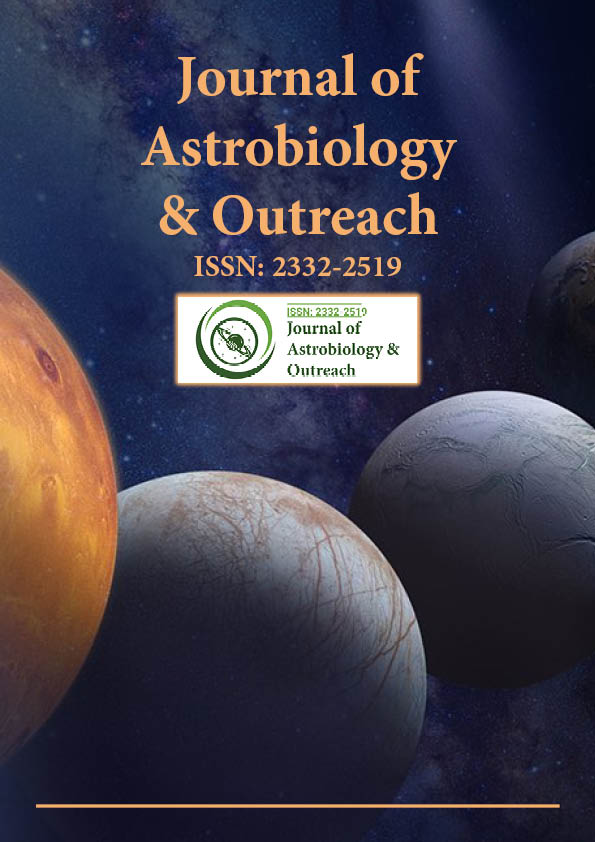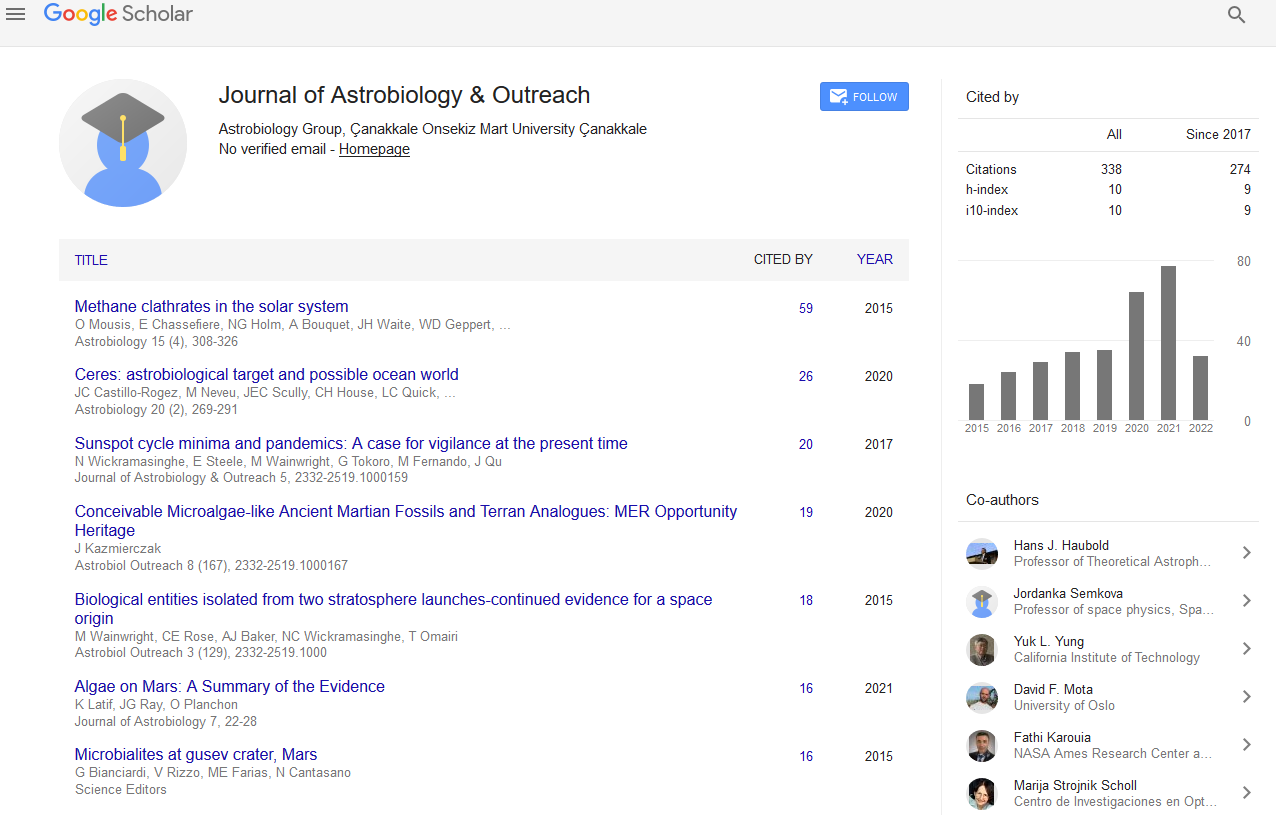Indexed In
- Open J Gate
- Academic Keys
- JournalTOCs
- RefSeek
- Hamdard University
- EBSCO A-Z
- OCLC- WorldCat
- Google Scholar
Useful Links
Share This Page
Journal Flyer

Open Access Journals
- Agri and Aquaculture
- Biochemistry
- Bioinformatics & Systems Biology
- Business & Management
- Chemistry
- Clinical Sciences
- Engineering
- Food & Nutrition
- General Science
- Genetics & Molecular Biology
- Immunology & Microbiology
- Medical Sciences
- Neuroscience & Psychology
- Nursing & Health Care
- Pharmaceutical Sciences
Commentary - (2025) Volume 13, Issue 2
Meteoritics and the Cosmic Context of Solar System Explored through Space Missions
Gerda Walter*Received: 16-Dec-2023, Manuscript No. JAO-23-24463; Editor assigned: 19-Dec-2023, Pre QC No. JAO-23-24463; Reviewed: 02-Jan-2025, QC No. JAO-23-24463; Revised: 22-Jan-2025, Manuscript No. JAO-23-24463; Published: 29-Jan-2025, DOI: 10.35248/2332-2519.25.13.378
Description
Meteoritics, the scientific study of meteorites to separating the mysteries of solar system's formation and the cosmic processes that shaped it. These extraterrestrial rocks, remnants of celestial bodies that have traversed the vastness of space to reach planet, carry invaluable information about the early stages of solar system and the larger universe. Meteorites, often considered as messengers from space, are remnants of asteroids, comets, or even other planets that have survived their fiery journey through Earth's atmosphere to land on planet. These celestial rocks come in various shapes and sizes, ranging from small dust particles to large masses weighing several tons. The study of these extraterrestrial specimens not only helps scientists understand the formation and evolution of solar system but also provides a glimpse into the broader processes occurring in distant corners of the universe.
Meteorites are of three types: Stony, iron, and stony-iron. Stony meteorites, the most common type, are composed primarily of silicate minerals and make up about 94% of all meteorites found on Earth. Iron meteorites, as the name suggests, are largely composed of metallic iron and nickel, constituting about 5% of meteorites. Stony-iron meteorites, comprising a mere 1%, exhibit a combination of both silicate minerals and metallic components. Each type offers unique insights into the conditions and materials present during the early stages of solar system's formation.
One of the contributions of meteoritics lies in its ability to provide a chronological record of events in solar system. By analyzing the age of meteorites, scientists can determine the timing of various celestial phenomena, such as the formation of planets and the onset of different geological processes. Radiometric dating techniques, such as the decay of isotopes like uranium and potassium, enable researchers to estimate the age of meteorites with remarkable precision. Isotopic analysis of meteorites reveal signatures of nucleosynthetic processes that occurred in previous generations of stars, providing clues about the cosmic environment in which solar system was born. These chemical fingerprints help scientists trace the origins of the building blocks that eventually merged to form Earth and its neighboring planets. In addition to their scientific significance, meteorites have captivated the human imagination for centuries. Witnessed falls, where meteorites are observed entering Earth's atmosphere and subsequently recovered, have been documented throughout history.
The hoba meteorite in Namibia, for instance, is a massive iron meteorite that fell to Earth about 80,000 years ago and remains one of the largest single pieces of iron ever found on the planet. Such spectacular events have inspired respect and interest, fueling both scientific inquiry and the popular imagination. Beyond their role in understanding the past, meteorites also have implications for the future. Studying these celestial rocks can aid in comprehension of potential threats from space, such as asteroids that might collide with Earth. By examining the composition and structure of meteorites, scientists can better assess the nature of these extraterrestrial bodies and develop strategies for planetary defense, ensuring the continued safety of planet.
The study of meteoritics extends beyond Earth, contributing to understanding of other celestial bodies in solar system and beyond. Missions to asteroids and comets, such as NASA's OSIRIS-REx and Japan's Hayabusa2, aim to collect samples from these bodies to further knowledge of their composition and origins. The insights gained from meteoritics lay the groundwork for interpreting the data returned by these space missions, enhancing understanding of the broader cosmic context in which solar system exists. Meteoritics serves as a vital field of study that unlocks the mysteries of solar system and the wider universe. From providing a chronological record of celestial events to offering insights into the chemical composition of the early solar nebula, meteorites play a pivotal role in advancing understanding of the cosmos, to explore and analyze these extraterrestrial rocks, inch closer to unraveling the secrets of cosmic origins and gaining a deeper appreciation for the interconnectedness of the universe.
Citation: Walter G (2025) Meteoritics and the Cosmic Context of Solar System Explored through Space Missions. J Astrobiol Outreach. 13:378.
Copyright: © 2025 Walter G. This is an open-access article distributed under the terms of the Creative Commons Attribution License, which permits unrestricted use, distribution, and reproduction in any medium, provided the original author and source are credited.

